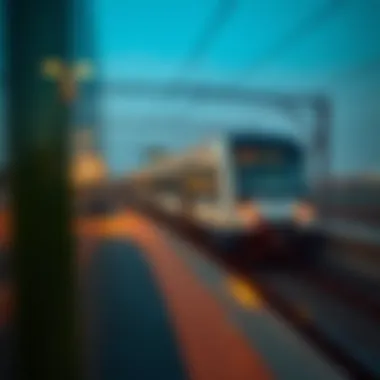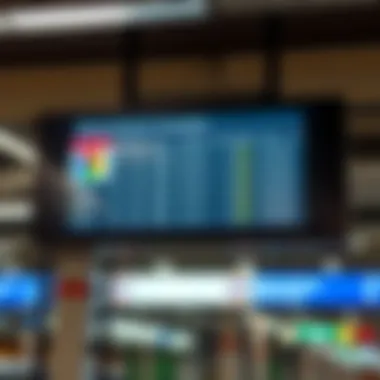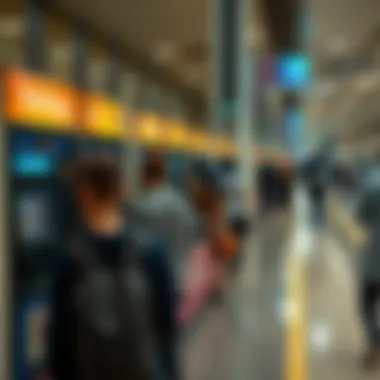Metro Working Hours in Dubai: A Detailed Guide


Intro
Navigating a bustling city like Dubai often hinges on understanding its public transport systems, particularly the metro. An essential artery for commuters, the Dubai Metro is more than just a transit option; it forms a vital part of the urban landscape, impacting daily routines and the overall economy. Are you aware of the current working hours, or have you ever considered how much they can shape the commuting experience?
The metro caters to a diverse audience, from residents relying on it for their daily commutes to tourists eager to explore the city. With its expansion and the ever-changing dynamics of the city's demographic, understanding the ins and outs of the metro working hours is critical. But this topic goes beyond mere schedules; it encompasses historical significance, the current operational landscape, and foresight into what might lie ahead. This is particularly relevant for investors and residents who depend on this urban infrastructure to make decisions.
As we delve into this comprehensive overview, it's vital to appreciate how these working hours align with the ebb and flow of the city itself. More than just numbers, these hours reflect the hustle and bustle of a vibrant metropolis, inviting analysis of current trends and future implications.
In setting the stage, we’ll touch on what shapes the metro's service hours, exploring how they ripple through other sectors, including real estate and tourism. Residents and visitors alike will find value here, as the insights offered aim to create a clearer picture of life in this modern marvel.
The journey into the world of the Dubai Metro’s working hours reveals much more than the logistical aspects. It’s a lens through which the evolving skylines, bustling streets, and the very fabric of Dubai can be viewed. Therefore, it’s crucial to remain aware of this intricate network and its influence as we navigate through our narrative.
Intro to Dubai's Metro System
The Dubai Metro has become a pivotal component of the city's transportation landscape, acting as a conduit for both residents and tourists alike. It not only alleviates congestion on the roads but also paints a picture of modern efficiency and urban planning. Understanding the metro system is crucial for anyone engaging with Dubai, from investors eyeing real estate potential to tourists exploring the vibrant landscape.
Historical Background
Launched in September 2009, the Dubai Metro was a part of a larger vision to transform the city's infrastructure, mirroring its rapid economic growth and urban expansion. The inception of the metro was driven by several factors, such as the increase in population, expanding urban sprawl, and the necessity to promote sustainable transportation. The first line, known as the Red Line, initially spanned 52 kilometers, connecting key areas of the city including the Dubai Mall and the Burj Khalifa. This was a monumental achievement for the UAE, as it marked the first fully automated metro system in the Arab world.
Since the first line’s launch, additional extensions, such as the Green Line, have only added to its importance. The metro served not just as a matter of transit, but as a catalyst for urban development, leading to the emergence of numerous commercial and residential projects along its corridors.
Significance in Urban Mobility
The significance of the Dubai Metro in urban mobility cannot be overstated. It has reshaped the commuter habits of countless residents. By providing an alternative to car travel, it reduces traffic congestion and emissions, improving air quality in a city known for its futuristic skyline. The efficient scheduling and coverage of the network make it an attractive option for both daily commuters and casual travelers.
One of the remarkable features of the metro is its extension into the broader public transport network of Dubai, which includes buses and water taxis. This seamless integration ensures that individuals can navigate the city with relative ease, further solidifying the metro's role in urban mobility.
"The introduction of the Dubai Metro is viewed as a quantum leap in public transport, merging speed with convenience for both residents and visitors."
In summary, the Dubai Metro stands as a testament to the city's ambition to create a world-class infrastructure. The historical evolution showcases its growth and adaptability, while its relevance emphasizes the practicality of using public transit in a rapidly developing urban environment.
Current Operating Hours
Understanding the current operating hours of Dubai's Metro is essential for any traveler or resident in the city. These hours are not just mere numbers; they represent the lifeline of a bustling urban environment. The timeframes within which the metro operates heavily influence commuter habits, business transactions, and overall urban dynamics. Knowing when you can count on the metro allows you to plan your day efficiently, whether you're heading to work, exploring the city, or making important investments.
Weekday Schedule
On weekdays, the Dubai Metro runs with a predictable yet dynamic schedule. Typically, the metro operates from 5:00 AM to midnight from Saturday to Thursday. This generous timeframe allows commuters ample opportunity to use the metro at various times of the day.
- Morning rush hours start at around 7:00 AM, seeing a surge of riders making their way to offices and schools.
- During the day, trains are surprisingly frequent, with waiting times as short as 2 to 5 minutes between trains. This helps ease congestion on increasingly busy weekdays.
- The evening rush hour kicks into gear around 5:00 PM, as the working population heads home.
Understanding this schedule is pivotal for investors and analysts who gauge peak hours for business activities. Knowing how many people utilize the metro during specific times can aid in making informed investment decisions in nearby real estate or services.
Weekend Schedule
When the weekend rolls around, typically Friday and Saturday in Dubai, the operational hours of the metro shift to accommodate leisure activities. The metro operates from 10:00 AM to 1:00 AM on Friday, which is slightly later in the morning compared to weekdays. On Saturdays, it resumes the weekday schedule of 5:00 AM to midnight. This distinction is essential for those looking to enjoy vibrant Friday brunches or weekend escape plans.


- These changes cater to the social schedules of residents, supporting late-night outings and events.
- Travelers should anticipate longer wait times during the evenings due to the influx of social engagement, making it vital to plan accordingly.
- For investors, recognizing these busy times can highlight opportunities for businesses that cater to social activities, especially those located near metro stations.
Holiday Variations
During holidays, the metro schedules can vary significantly. Understanding these variations is important for anyone planning to travel during the festive seasons. For instance, during Eid and public holidays, the metro may operate on special schedules, typically releasing updates well in advance. It's vital to remain informed about these changes, as they can lead to:
- Extended hours, allowing late-night festivities.
- Adjusted service frequency to handle increased passenger volumes during peak holiday travel.
- Temporary service suspensions or modifications—such as shut-down times during major religious observances.
Travelers should keep track of announcements via RTA's official site, where information about operational hours during specific holidays is often posted. Being aware of these changes enables efficient planning for those special days when public transport serves as a crucial mode of travel.
Key takeaway: Understanding the current operating hours of the Dubai Metro is vital for smart commuting, effective business planning, and ensuring a smooth travel experience in this vibrant city.
Impact of Operating Hours on Commuters
Understanding the effect of the operating hours of the Dubai Metro is crucial for anyone relying on this system for daily travel. The time frame in which the metro operates not only influences the commuting patterns of workers but also shapes the accessibility of various destinations throughout the city. Aspects such as the frequency of trains during specific hours, consideration for peak travel times, and integration of services can make or break the commuting experience.
Commuter Patterns and Preferences
When discussing commuter patterns, it becomes clear how vital the timing of metro services is. Take, for instance, the average office worker in Dubai: many are expected to start their day between 8:00 AM and 9:00 AM. During these hours, the metro sees a surge in ridership, leading to crowded trains and longer wait times. Many commuters may prefer to leave earlier to avoid the rush or adjust their schedules based on the availability of services. This flexibility is often a balancing act of productivity and comfort.
- Morning Rush Hour: Generally spans from 7:00 AM to 9:00 AM. Commutes during this window can feel like a game of sardines.
- Evening Rush Hour: Tends to pick up after 5:00 PM going through to about 8:00 PM, forcing many to strategize with their travel plans.
- Non-Peak Times: Contrarily, times outside these windows often afford commuters a much more relaxed journey, allowing for a space of personal comfort.
Moreover, preferences in using the metro can differ based on the demographics of the riders. Workers in corporate industries may plan heavier use of the metro during those peak hours, while tourists might not experience the same constraints, choosing to travel at leisure, perhaps to see specific attractions.
Peak vs. Off-Peak Travel
The distinction between peak and off-peak travel hours fundamentally alters the commuter landscape. During peak times, trains run frequently, yet the sheer volume of passengers creates challenges that can erode the convenience the Metro typically offers.
In contrast, off-peak hours present a different tableau. Understanding the advantages of these times can provide commuters with more than just a peaceful ride:
- Shorter Wait Times: Trains arrive with insufficient crowds, making them easier to board, especially during busy hours.
- Safer Environment: Reduced numbers mean social distancing is much easier, significant in a post-pandemic world.
- Opportunities for Exploration: Enjoying a leisurely trip, travelers can take advantage of the time to plan their activities in a less rushed environment.
In essence, grasping how operating hours affect commuter behavior and preferences aids in navigating Dubai's Metro with ease. An informed traveler can determine the optimal times to ride for a seamless experience.
"For daily commuters, timing their journey can often feel like a game of chess; only the wise ones know when to make their next move."
With the recent trends in metro operations and the evolving urban fabric of Dubai, the relationship between working hours and commuter dynamics remains a crucial focus for both riders and planners.
Future Developments in Metro Operations
As Dubai continues its march toward modernization and sustainability, the role of the metro system in evolving urban mobility cannot be overstated. Future developments in metro operations are crucial for addressing the challenges of a growing city, ultimately enhancing the lives of commuters and boosting economic activity. In this section, we will examine planned extensions and new lines, along with technological innovations slated to transform the metro experience for residents and visitors alike.
Planned Extensions and New Lines
The Dubai Metro's expansion has been a topic of great interest among urban planners and commuters alike. The planned extensions are designed not just to accommodate a growing population but also to connect vital areas across the emirate more effectively. Key proposals include:
- Route 2020: Set to extend the Red Line by several kilometers, this will link the metro to the site of Expo 2020 (now Expo 2021). This connection will facilitate smoother access to an international audience, making travel more accessible.
- Blue Line Consideration: Talks surrounding the introduction of a new Blue Line that might run parallel to the existing lines have emerged. This could significantly improve travel times and ease congestion during peak hours.
These extensions are pivotal for


- Enhancing property values in newly-linked areas
- Encouraging investment in commercial developments around stations
- Improving the integration of public transport into daily life for residents
Moreover, as the metro network expands, it will likely boost tourism, making it even more vital for visitors keen to explore the city without facing heavy traffic.
Technological Innovations
In today's digital age, technological upgrades are foundational to improving metro operations. Dubai’s Metro is no stranger to innovation, and upcoming technological advancements promise to enhance commuter experience significantly. Important innovations include:
- Smart Ticketing Systems: The introduction of mobile ticketing options allows passengers to purchase tickets through apps, which can help ease congestion at ticket counters. Swift and effortless, this will be a game-changer for many, especially during rush hours.
- Real-Time Tracking: With live updates on train schedules and delays via mobile applications, commuters will no longer need to fret about waiting indefinitely. Knowing precisely when the next train arrives can save time and frustration.
- Sustainability Features: Future metro cars are planned to include energy-efficient technologies, such as regenerative braking systems. This initiative not only reduces energy consumption but also aligns with the UAE’s commitment to sustainable practices.
The implications of these technologies are immense. By enhancing operational efficiencies, they will increase ridership while lowering the overall carbon footprint of transport in the city.
Practical Tips for Using the Metro
Navigating the Dubai Metro can be a straightforward task, but without the right tips, you may find yourself floundering, especially if you are new to the city. This section arms you with valuable insights that can make your commuting experience smoother and more efficient. Knowledge of practical tips can save you time, money, and even unnecessary stress when using this vital transportation link.
Buying Tickets and Passes
Understanding the ticketing system is half the battle when it comes to using the metro efficiently. Dubai Metro operates on NOL cards, which are reusable smart cards used for fare collection. Here are some crucial elements to consider:
- Types of NOL Cards: There are several types available: the Red Ticket for occasional travelers, the Blue Card for regular commuters, and the Green Card for limited journeys within a certain zone. Choosing the right card depends on your commuting frequency.
- Where to Buy: Tickets and cards can be purchased at ticket vending machines located in every metro station. These machines are user-friendly, offering instructions in multiple languages.
- Load Your Card: Whether you choose a one-time travel option or a regular pass, loading your card with sufficient credit in advance ensures there are no hiccups during your journey.
Purchasing your tickets or passes correctly can greatly enhance your metro experience.
Navigating the Stations
Once you have your ticket, the next hurdle is and navigating the stations efficiently. Each metro station in Dubai is equipped with clear signage and helpful staff, but knowing a few tips can make your journey more seamless.
- Station Layout: Familiarize yourself with the layout of key stations, especially interchanges like Burj Khalifa/Dubai Mall on the Red Line or Union Station, which links both lines. Knowing where to go upon arrival can help avoid unnecessary confusion.
- Accessibility Options: The metro supports passengers with reduced mobility, offering facilities like elevators and designated seating. Finding these amenities can ease your transit experience.
- Real-Time Information: Utilize the metro app or screens at the station to anticipate train arrivals and departures. This can save you the hassle of waiting unexpectedly.
With these navigation tips, you can traverse the stations like a pro.
Travel Etiquette
Practicing proper travel etiquette is something that often gets lost in transit. Keeping a few key points in mind can improve your experience — and the experience of others around you.
- Designated Areas: Keep to the designated areas, especially in the women and children sections if you don’t fall within these categories. Being aware of such allowances shows respect for your fellow commuters.
- Noise Levels: Maintain a reasonable noise level; loud conversations and phone calls can be considered disruptive. Remember, people are utilizing the metro for a variety of reasons, often requiring concentration or quiet time.
- Giving Way: Always let passengers alight the train before stepping in. This simple act goes a long way in keeping the flow of travel smooth.
In summary, practicing good travel etiquette is not just about rules; it’s about contributing to a comfortable environment for everyone.
By keeping these practical tips in mind, you can turn your metro journey into a seamless and enjoyable part of your daily routine in Dubai. Whether you're a commuter, a tourist, or a professional investor, understanding these nuances of using the Dubai Metro can significantly elevate your experience.
For more information on the Dubai Metro system, visit Dubai Metro Official Site or check out the Dubai RTA page.
Metro's Role in Dubai's Real Estate Market
The Dubai Metro is more than just a mode of transportation; it serves as a crucial catalyst in shaping the real estate market within the emirate. When discussing the influence of the metro on property dynamics, one must consider how connectivity and accessibility reshape buyer and investor behaviors. As the metro expands, so does the enthusiasm around properties near its stations. Many view being close to a metro stop as a key selling point, one that adds considerable value to a property.


Influence on Property Values
The proximity to the Dubai Metro has proved to be a game-changer for various residential and commercial properties. According to numerous real estate reports, properties situated within walking distance of metro stations often command significant premiums. A study showed that homes near the metro witnessed a value increase of 15% to 20% over a five-year span compared to their more distant counterparts.
- Access to Major Areas: The metro links key destinations, from business hubs like the Dubai International Financial Centre to tourist hotspots such as the Burj Khalifa and the Dubai Mall. This accessibility enhances the allure of nearby properties, making them particularly attractive for buyers looking for easy commutes.
- High Demand for Rentals: Investors tend to secure higher rental yields from properties near metro stations, benefiting from both resident and transient populations, including tourists and expatriates drawn by the convenience the metro offers.
- Reduced Commute Times: Commuters can save valuable time, leading many to prefer metro-adjacent living arrangements. The shift in lifestyle preference towards convenience has undeniably elevated property values.
Attractiveness of Nearby Developments
The rise in property values is not just due to existing structures; it has also spurred urban development in regions adjacent to metro stations. When the metro lines are announced, a flurry of construction activities often follows as developers scramble to capitalize on the anticipated influx of residents.
- New Developments: New residential projects, shopping malls, and commercial spaces are often strategically positioned near metro lines. Developers design these projects with easy metro access as a priority, which enhances their marketability.
- Regulatory Support: The UAE government encourages transit-oriented development, making it easier for developers to build in these zones. As a result, zoning laws and incentives are often favorable toward projects that enhance the metro’s accessibility.
- Improved Infrastructure: Areas near metro stations typically receive upgrades in infrastructure such as roads, sidewalks, and public amenities, further enhancing the appeal of these neighborhoods.
"The metro isn't just a train line; it’s a lifeline, connecting Dubai's heart to its emerging neighborhoods."
Environmental Considerations
The role of the Dubai Metro in the broader context of environmental sustainability cannot be understated. As urban centers grapple with challenges related to congestion, pollution, and overall ecological impact, public transit systems like the metro emerge as vital players. In this section, we will explore two significant facets: sustainability initiatives and the reduction of carbon footprint.
Sustainability Initiatives
Dubai has embarked on a journey towards a more sustainable future, and the metro system is a key pillar of this effort. Several initiatives focus on minimizing environmental impacts and promoting responsible usage of resources. For instance:
- Energy Efficiency: The metro stations and trains are designed with energy-efficient technologies. From LED lighting to regenerative braking systems, these features actively reduce energy consumption while providing the necessary services.
- Water Conservation: Water usage in metro operations is thoughtfully managed. Stations have been equipped with technologies that minimize water wastage, such as smart irrigation systems for landscaping.
- Waste Management: The metro promotes recycling by providing bins for various materials. All stations are equipped to ensure waste is sorted correctly, reflecting a commitment to creating a cleaner environment.
Another noteworthy initiative is the integration of green building principles in all new metro construction projects. This aims to reduce raw material usage and often incorporates renewable energy sources when possible.
"Sustainable transport is not just a concept but a necessity for future generations."
Reduction of Carbon Footprint
The Dubai Metro plays an essential role in reducing the overall carbon footprint of the city. By offering a reliable and efficient alternative to private vehicles, it lessens the number of cars on the road. This shift has been instrumental in achieving lower emissions throughout the urban landscape. Consider the following impacts:
- Decreased Traffic Congestion: With more people opting for metro travel, traffic congestion has significantly decreased, leading to fewer idle cars emitting carbon.
- Public Awareness Campaigns: The RTA promotes the environmental benefits of using the metro through various campaigns. Educating the public on the relationship between reduced personal vehicle use and lower greenhouse gas emissions fosters a culture of sustainability.
- Investment in Clean Technology: The metro trains utilize advanced technologies that lower emissions and increase efficiency, making public transit a more attractive and environmentally friendly choice.
By emphasizing these elements, Dubai's metro system contributes to the city’s sustainable development goals, aligning with global standards to address climate change challenges.
Epilogue
The importance of the conclusion in this article cannot be overstated. It serves not just as a summary, but also as a strategic analysis of how the varied aspects of metro working hours intersect with daily life in Dubai. For investors, buyers, agents, and analysts, understanding these working hours provides pivotal insights into urban mobility and real estate dynamics.
Summary of Key Points
In this article, we’ve explored a range of topics concerning the Dubai Metro’s operational hours. Key points include:
- Historical Context: How the metro system evolved, reflecting the rapid growth of the city.
- Current Schedules: Detailed breakdown of weekday, weekend, and holiday operating hours, which holds immense relevance for daily commuters and tourists alike.
- Impact on Commuters: Insight into commuter patterns, highlighting the significance of peak and off-peak travel.
- Future Developments: Discussion on planned enhancements and technological advancements, which promise to affect future operations.
- Practical Usage: Tips on navigating the system efficiently, emphasizing buying tickets and general travel etiquette.
- Environmental Impact: A look into sustainability initiatives and how the metro contributes to reducing the carbon footprint in an urban setting.
This summary encapsulates the essence of how crucial the metro's scheduling is to enhancing commuter experiences and shaping Dubai’s urban landscape.
Future Outlook
As we look ahead, the Dubai Metro is poised for significant expansions and upgrades. With continuous investment in infrastructure, enhancements could lead to:
- Increased Capacity: New lines and extensions might alleviate congestion, accommodating a growing population and tourism.
- Technological Innovations: Implementation of smart ticketing and real-time tracking could streamline operations further, enhancing convenience for riders.
- Sustainability Goals: Future initiatives aiming for lower emissions and greener technologies may solidify the metro's role in Dubai’s commitment to environmental responsibility.
In sum, understanding the operating hours and the associated details not only enhances user experience but also provides key insights into the broader implications for urban planning and development in Dubai. For those engaged in the real estate market or urban development, such insights are absolutely invaluable.



